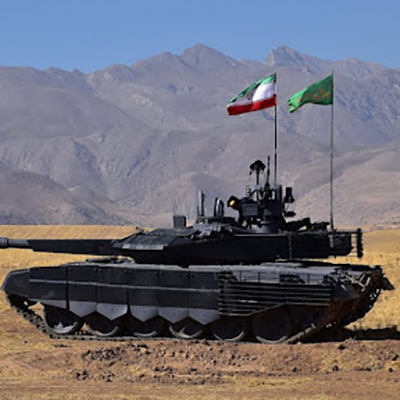Warfare
Tank
Mohsen Shir-Muhammad
136 Views
A tank is a tracked, armored vehicle equipped with a cannon and machine guns. Throughout the Iran-Iraq War, tanks acted as the most important weapon in ground warfare.
A tank is a fully armored combat vehicle equipped with continuous tracks, a direct-fire main gun, and multiple machine guns for secondary armament. The caliber of the main gun varies depending on the tank model and the country that built it. Tanks combine powerful firepower, full armor protection, high mobility, and reliable communications systems, making them the key weapon on the battlefield.
The modern tank was first designed during World War I by Ernest Dunlop Swinton, a British Army colonel. Its development process was kept completely secret at the time. To disguise its true purpose from German intelligence, the British labeled the production with the word “tank” (meaning water container), and the name has remained in use ever since.[1]
By 1980, just before the war started, Iran had 1735 tanks, including 400 M47 and M48s, 460 M60s (all American-made), 875 Chieftains, and 250 Scorpions (British-made).[2]
At the same time, Iraq had around 2750 tanks, including 50 T-72s, 2500 T-54s, T-55s, and T-62s, 100 T-34s (Soviet-made), and 100 AMX-30s (French-made).[3] Iraq also managed to assemble T-72s domestically and called them “Asad Babil”. These tanks featured a laser rangefinder, thick frontal armor, and an automatic loader for the main gun.
In tank-to-tank battles, the T-72 could hold its own against American-made M60s.[4] Its fire control systems, originally Soviet, were upgraded with Western-made rangefinders and computers.[5] The T-72s were the best tanks Iraq had during the war. They held up well against the RPG-7, which was the main anti-tank weapon used by Iranian infantry, and they played a big role in Iraq’s counterattacks.[6]
During the Iran–Iraq War, one of the largest tank battles took place on January 5, 1981, in Operation Nasr,[7] in which the 16th Armored Division of the Iranian Army was involved.[8] Five tank battalions formed the core of the division in this operation.[9] Despite initial advances, destroying some enemy equipment, and capturing 1200 Iraqi soldiers, the division was eventually pushed back after a counterattack by Iraqi forces on January 7[10] due to a lack of coordination and support.[11]
Iraqi forces were equipped with T-72s, which had an edge over Iranian tanks in terms of loading speed and rate of fire. With close air support and the use of Malyutka anti-tank missiles, Iraqis managed to drive back the 16th Division, which left behind 130 tanks and armored vehicles, including 87 Chieftains.[12]
At the time, the Islamic Revolutionary Guard Corps (IRGC) operated as a nimble force and did not rely much on heavy armor. Even though it built capable armored units, equipment like tanks stayed mostly with the Army and never became a strategic priority for the IRGC.[13]
During the war, Iran lost many of its tanks and could not replace them. Therefore, tanks were increasingly used not for independent maneuvers but more like mobile artillery or in support of infantry.[14]
When mobility was essential, Iranian forces preferred the M60 over the Chieftain because of its speed and agility.[15]
During the war, Iraq upgraded some of its T-55 tanks by equipping them with 125 mm cannons to boost firepower. Some were also armed with synthetic armor for better protection. In addition, both T-55s and T-72s were outfitted with mine-clearing equipment, allowing them to lead offensives into Iranian minefields.[16]
Between 1984 and 1988, Iran purchased 1000 T-54 and T-55 tanks and 260 T-59s[17] from Libya and North Korea.[18] It also captured 600 Iraqi T-55s, 200 T-62s, and 29 T-72s.[19] However, losses were heavy, and many of the tanks were not fully operational either due to a shortage of spare parts or a lack of qualified maintenance personnel.[20]
Iranian T-59s and T-72s did not have proper fire control systems. Therefore, they could not hit targets reliably on the first shot or fire accurately while moving. However, the guns mounted on them had good capabilities, and their direct-fire systems were easier to operate than the more advanced fire control systems used in typical tank-on-tank combat.[21]
After the war, in the early 1990s, the Iranian Army’s Self-Sufficiency Jihad Organization started developing a homegrown tank called Zolfaqar. The project eventually led to the design and production of the Zolfaqar 1 in 1996. Later, in early 2017, Iran unveiled the Karrar, its most advanced tank, and launched its mass production line at the Bani-Hashem Armor Industrial Complex in Doroud. Karrar is essentially an upgraded version of the T-72 tank.[22]
[1] Rostami, Mahmoud, Farhang-e Vazhehaye Nezami (Military Terms Dictionary), Tehran, Iran Sabz, 2nd ed., 1386, p. 246.
[2] Cordesman, Anthony and Abraham Wagner, Dars-ha-ye Jang-e Modern – Jang-e Iran va Araq (Lessons of Modern War – Iran-Iraq War), Vol. 1, trans. Hussain Yekta, Tehran, Marz-o Boom, 1390, Pp. 145, 374.
[3] Ibid.
[4] Blackwell, James, Saeqe dar Sahra (Thunderbolt in the Desert), trans. Hamid Farhadi Nia and Houshmand Namvar Tehrani, Tehran, Entesharat-e Ettelaat, 1372, p. 106.
[5] Cordesman, Anthony and Abraham Wagner, Ibid., Vol. 2, p. 338.
[6] Ibid.
[7] Bozorgtarin Nabard-e Tank-ha Bad az Jang-e Jahani-ye Dovom dar Goftogu ba Farmandehan-e Amaliyat-e Nasr (Hoveyzeh) (The Largest Tank Battle after World War II in an Interview with Commanders of Operation Nasr [Hoveyzeh]), Mahnama-ye Ghadir, No. 3, Dey 1385, p. 11.
[8] Hussaini, Seyyed Yaqoub, Amaliyat-e Nasr (Operation Nasr), Tehran, Iran Sabz, 1393, Pp. 350–351.
[9] Vizhehname-ye Soore Mehr (Soore Mehr Special Publication), No. 3, Shahrivar 1391, p. 23.
[10] Ibid.
[11] Abughazaleh, Abdolhalim, Jang-e Iran va Araq (Iran-Iraq War), Tehran, Markaz-e Motaleat va Tahqiqat-e Jang-e Sepah-e Pasdaran, p. 362.
[12] Alaei, Hussain, Ravand-e Jang-e Iran va Araq (The Course of the Iran-Iraq War), Vol. 1, Tehran, Marz-o Boom, 1391, p. 290.
[13] Shiralinia, Jafar, Dayerat-ol-maaref-e Mosavvar-e Tarikh-e Jang-e Iran va Araq (Illustrated Encyclopedia of the History of Iran-Iraq War), Tehran, Sayan, 1392, p. 209.
[14] Cordesman, Anthony and Abraham Wagner, Ibid., Vol. 2, p. 337.
[15] Ibid., p. 338.
[16] Ibid., p. 339.
[17] Ibid., p. 330.
[18] Yousef-Aqdam, Karim, Amad va Poshtebani-ye NEZAJA dar Hasht Sal-e Jang-e Tahmili (Readiness and Support of the Army Ground Force in the Eight-Year Imposed War), Tehran, Heyaat-e Maaref-e Jang Shahid Sepahbod Ali Sayyad Shirazi, 1401, Pp. 73–74.
[19] Jafari, Fathollah, Chennaneh – Khodnegasht-e Fathollah Jafari (Chennaneh – Memoirs of Fathollah Jafari), Tehran, Markaz-e Asnad va Tahqiqat-e Defa Muqaddas, 1402, Pp. 440, 441, 445.
[20] Ibid.
[21] Ibid., p. 338.
[22] Gamhaie ke Baraye Tolid-e Tank dar Iran Bardashte Shod (Steps Taken for Tank Production in Iran), Khabargozari Fars, 3 Dey 1397, https://farsnews.ir/politics/1547929980000970521





